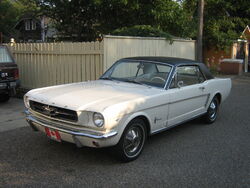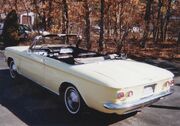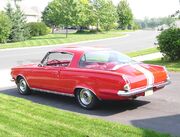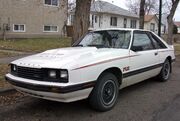- Not to be confused with the Hyundai Pony car.

1965 Ford Mustang
Pony car is an American class of automobile launched and inspired by the Ford Mustang in 1964.[1][2] The term describes an affordable, compact, highly styled car with a sporty or performance-oriented image."[3][4]
Origins of the breed[]
The pony car had its beginnings at Ford Motor Company in the late 1950s following the demise of the original, two-seat Ford Thunderbird. While the Thunderbird's transformation into a larger, four-seat personal luxury car, starting with the 1958 model year, proved to be successful in sales terms, dealers and buyers alike lamented the loss of the two-seat Thunderbird, which served as a halo car (image leader) for the company and a traffic-builder in showrooms, attracting buyers who would ultimately purchase more mundane automobiles. For several years Ford explored various plans for reviving some equivalent of the early Thunderbird.

1964 Corvair Monza
An added impetus came from Chevrolet, with the popularity of the Chevrolet Corvair introduced in 1960. The sporty Monza version of the Corvair was the catalyst that Ford needed to create the now instantly recognizable Mustang. The initial Corvair had been positioned as an economy car, but it was much more successful with the plusher trim and sportier image of the Monza model that included bucket seats and a floor-mounted transmission shifter, which sold around 144,000 units by 1961—starting a trend toward sportier cars with bucket-seats in all sizes from compacts to full-size cars. Ford responded to the compact Corvair Monza with sportier Futura and Futura Sprint versions of its Ford Falcon, and Chrysler with the Plymouth Valiant Signet and Dodge Dart GT, as well as American Motors (AMC) with the 440-H and Rogue versions of the Rambler American,[5] and Studebaker with the sporty Daytona version of its compact Lark. Other sporty bucket-seat compact cars that appeared during the early 1960s included the Mercury Comet S-22, Oldsmobile F-85 Cutlass, Buick Special Skylark, and Pontiac Tempest LeMans. Most of these sporty compacts came standard with the same economical six-cylinder engines as their more mundane counterparts, but in some cases more powerful V8 engines were at least optional along with four-speed manual transmissions and center consoles housed between the front bucket seats.
Some technical developments of the early sporty compact cars offered in the U.S. (1961–63) included a turbocharged six-cylinder in the rear-engine Corvair Monza Spyder/Corsa (1962–66), turbocharged aluminum V8 on the 1962–63 Oldsmobile Cutlass Jetfire and a standard 194 cu in (3.2 L) four-cylinder engine mated to a rear transaxle on the 1961–63 Pontiac Tempest LeMans in several states of tune, including a four-barrel high-performance option, as well as (in 1963) a large (for a compact car) 326 cu in (5.3 L) V8 that was optional with up to 280 hp (209 kW).
Although the sporty compacts were a commercial success for most automakers, some auto executives, however, principally Ford's Lee Iacocca, believed that sporty versions of mundane compact cars only scratched the surface of the potential market. During this period there was a strong influx of young buyers with discretionary income and a taste for vehicles with a younger image than a standard sedan, and Iacocca's marketing studies revealed that if a unique-looking sporty car could be offered at an affordable price, it would find many buyers. Ford's response to this demand was the Mustang, launched on April 17, 1964, which proved to be an enormous success. The company was forecasting sales for the first year to reach 100,000 units. However, Ford dealers took 22,000 orders the first day and the company had to shift production mid-year. The extended model year sales totaled 618,812 Mustangs.[6]
Defining the class[]
The 1964 Mustang provided the template for the new class of automobiles.[7][8] The term itself "was coined by Dennis Shattuck, who was editor of Car Life magazine" at the time.[9] The term "originates from the equestrian sounding Ford Mustang",[2] and may also refer to the Ford Mustang's logo (a galloping pony).
Although the Mustang was based on the platform of the Falcon, it had a unique body (offered as a hardtop coupé and a convertible) with distinctive, "long hood, short deck" proportions. In basic form it was mechanically mundane, with a 170 cu in (2.8 L) six-cylinder engine coupled to a three-speed manual transmission. It carried an attractive base price of US$2,368 that included bucket seats, carpeting, floor shifter, sport steering wheel, and full wheel covers. The Mustang also had an extensive option list offering a range of V8 engines, Cruise-O-Matic automatic transmission or four-speed manual gearbox, radios, air conditioning, power steering, and other accessories.[10] A V8 Mustang with all available options would cost about 60% more than a basic model with a six-cylinder engine, which made it an extremely profitable model for Ford.[11]
The requirements for these two-door, four passenger capacity models were therefore set:[12][13]
- Stylish and sporty styling that included "long hoods, short decks, and open mouths"
- Assembled from "off-the-shelf" mass production components
- Affordable base price (under $2,500 — in 1965 dollar value)
- Wide range of options to individualize each car
- Youth-oriented marketing and advertising.
While most of the pony cars offered more powerful engines and performance packages, enough to qualify some into muscle car territory, a substantial number were sold with six-cylinder engines or ordinary V8s.[14] For the most part, the high-performance models saw limited sales and were largely limited to drag racing, road racing, or racing homologation purposes.
Pony car competitors[]

1965 Plymouth Barracuda

1968 Chevrolet Camaro

1969 AMC Javelin
Despite the immediate success of the Mustang, many (including some within Ford) feared that the bubble would soon burst, and other manufacturers were relatively slow to respond. The first competitor was the Plymouth Barracuda, which actually went on sale on April 1, 1964, about two weeks before the Mustang.[15] The Barracuda was not a direct response to the Mustang, which had not yet debuted (although Chrysler was certainly aware of the upcoming model), but a low-cost way to expand the sporty appeal of the Valiant. Chrysler's precarious financial situation meant that the Barracuda was compromised, with insufficient distinction from the Valiant and styling that drew mixed reactions; its sales were a fraction of the Mustang's. It has been described that if the Barracuda was successful, as well as the similar fastback Rambler Tarpon introduced as planned before the Mustang,[1] the term for this class of automobile might have been "fish car," rather than "pony car."[2][16] However, the Mustang, unlike the Barracuda, featured a completely unique body style from the car on which it was based (the Ford Falcon), making it the first true pony car.[17]
Initially, General Motors believed that the restyled 1965 Corvair would be an adequate challenger for the Mustang, but when it became clear that the Corvair itself was doomed, the more conventional Chevrolet Camaro was introduced,[13] going on sale for the 1967 model year, at the time the Mustang received its first major redesign. They were also joined by the Camaro-based Pontiac Firebird and the Mustang-based Mercury Cougar. American Motors joined late in 1967 with the AMC Javelin,[18] described by race driver Gordon Johncock "as a roomy, comfortable, peppy and handsome example of a so-called pony car, the type of automobile that's showing up more and more on US highways."[19] February 1968 was the introduction of AMC's two-seat AMX at the Daytona International Speedway. Not much bigger than European sports cars, but with purely American performance,[18] the AMX was "a Walter Mitty Ferrari" with a "truly distinctive long-hood/really-short-deck profile [that] nearly redefined the pony car image."[20] The U.S. "market was filled with pony cars ... however the AMC Javelin was not the last pony car to hit the showrooms—it was Dodge's 1970 Challenger", an enlarged version of the Barracuda.[21][22]
The pony car classification was applied to all versions of these nameplates, from the base economy models, as well as models with more equipment, features, or the "muscle" performance models.[23] The intention of these performance models and factory support in racing was on developing a competitive marketing image for their pony cars.[24] The automaker's marketing department's strategy was to promote a perception of these as "sports-type" muscle and performance to promote sales. The competition between the manufacturers was so fierce that the Trans-Am Series from 1966 to 1972 is described as "The Pony Car Wars".[25]
While sales were strong throughout the end of the 1960s, the greater value of the pony cars was in bringing buyers, particularly the crucial youth market, into the fold. In 1970 Car and Driver reported that while very few pony car drivers bought a second pony car, around 50% moved on to purchase another car of the same make. Nevertheless, even by 1969 sales were beginning to slide, dropping to 9% of the total market, from a peak of 13% in 1967.
The pony car was primarily an American phenomenon, but in 1969, with the continuing growth in this market segment Ford managers decided to introduce a European equivalent in the Ford Capri.[26] Sharing most of its underpinnings and some engines with an ordinary model, (the Ford Cortina), it had a combination of style and image very much in the spirit of the Mustang. The European Ford Capri (sold in the U.S. as a Mercury Capri through 1978 at Lincoln-Mercury dealerships) was last imported for the 1978 model year, and the nameplate was placed on a rebadged Fox-body Mustang through 1986.
The following is a list of muscle cars and their manufacturers (along with the pony car of the same company):
| Manufacturer | Pony car | Muscle car |
|---|---|---|
| AMC | Javelin SST | Machine |
| Buick | none | Gran Sport |
| Chevrolet | Camaro | Chevelle SS |
| Dodge | Challenger | Charger RT |
| Ford | Mustang | Torino GT |
| Mercury | Cougar | Cyclone CJ |
| Oldsmobile | none | 442 |
| Plymouth | Barracuda | Road Runner |
| Pontiac | Firebird | GTO |
Expansion and decline[]
| This section needs additional citations for verification. Please help improve this article by adding citations to reliable sources. Unsourced material may be challenged and removed. (December 2009) |

1972 Dodge Challenger
As with most automobile redesigns, each subsequent generation of the pony cars grew somewhat larger, heavier, costlier, and more plush. Big-block engines joined the option list, and both performance and comfort options proliferated. The 1973 Mustang, for example, was 8.5 inches (216 mm) longer, 5.9 inches (150 mm) wider, and over 600 pounds (272 kg) heavier than the original edition. The Dodge Challenger, meanwhile, was only slightly smaller and lighter than Dodge's intermediate cars. The added bulk left the standard six and V8 engines sorely pressed, while the introduction of powerful big-blocks underscored the limitations of the pony cars' suspension, brakes, and tires.
By 1970 buyers were moving away from the pony cars, either toward smaller compact cars (domestic or imported) or toward larger, more luxurious models. Performance of the hottest pony cars began to erode as a result of emissions controls and the added weight of required safety features. The 1973 oil crisis left the bulky pony cars out of step with the marketplace.
The Challenger, Barracuda, and Javelin were cancelled after 1974, and the Camaro and Firebird nearly died at the same time, although they received last-minute stays of execution. The Cougar became an upscale personal luxury twin to the Ford Thunderbird, while the Mustang was reinvented as the Mustang II and marketed as fuel efficient compact with luxury or sporting trim pacakges.
Later developments[]
| This section needs additional citations for verification. Please help improve this article by adding citations to reliable sources. Unsourced material may be challenged and removed. (December 2009) |

Early-1980s Mercury Capri
Popularity was culturally promoted by such examples as the Firebird Trans Am in popular movies such as Smokey and the Bandit, and TV programs such as The Rockford Files and Knight Rider, the GM pony cars experienced resurgence in popularity in the late 1970s that helped ensure their continuation. The Mustang was redesigned with a renewed sporty image in 1979, prompting Mercury to reenter the pony car market with a Mercury Capri twin based on the new Mustang. Chrysler, beset by financial problems, did not revive the pony car, although it did offer other front-wheel drive performance models with a similar spirit. American Motors brought back its AMX model name to the performance-oriented I6 or V8 powered rear-drive Spirit, a similar car to the Mustang hatchback of that era.
Sales of the Mustang remained strong, although in the 1980s Ford gave serious consideration to replacing it with a front-drive model (which eventually appeared as the Ford Probe instead). Emissions and fuel economy concerns led many of the latter-day pony cars to offer four-cylinder engines (sometimes with turbocharging), although they were never as popular as six-cylinder and V8 models.
By the mid 1980s, the pony car survivors (Mustang, Camaro, and Firebird) enjoyed a period of renewed popularity as progressively more and more powerful (yet relatively fuel-efficient) V8 engines were offered in performance-oriented versions of these vehicles. However, declining sales and the growing popularity of rear wheel drive light trucks and sport utility vehicles ultimately led to the demise of the Camaro and Firebird after the 2002 model year.
21st Century revival[]

2005-09 Ford Mustang GT
The dilemma facing automakers in offering pony cars (or their equivalent) going forward is developing a suitable platform that is affordable and capable enough to be viable. Unlike the mid-1960s, the large majority of modern compact cars are front-wheel drive, with four- and six-cylinder engines, and the widespread use of unibody construction makes engineering a specialized body an expensive proposition.
In 2005, Ford introduced a new Mustang based on a dedicated platform. The success of this model inspired Dodge to reintroduce the Challenger in 2008, and Chevrolet to reintroduce the Camaro for 2010, although the latter two differ from classic pony cars in being based on full-size car architectures.
Some automotive journalists have also dubbed the 2010 Hyundai Genesis Coupe as a pony car.[27][28]
NASCAR is bringing pony cars to its second-tier Nationwide Series at the Subway 250 race at Daytona International Speedway in Daytona, Florida, on Friday, July 2, 2010.[29] Dodge will race its Challenger, and Ford will race the iconic Mustang. The new cars are seen as a move by NASCAR to re-establish brand identity with fans and the cars on the track.[30] The pony cars are expected eventually to make their way to NASCAR's premier Sprint Cup Series.[31]
References[]
- ↑ 1.0 1.1 Mitchell, Larry G. (2000). AMC Muscle Cars. MotorBooks/MBI Publishing, 17. ISBN 9780760307618. Retrieved on 2010-11-10.
- ↑ 2.0 2.1 2.2 Grist, Peter (2009). Dodge Challenger Plymouth Barracuda: Chrysler's Potent Pony Cars. Veloce Publishing, 6. ISBN 9781845841058. Retrieved on 2010-11-10.
- ↑ Borroz, Tony (2009-04-17), "April 17, 1964: Ford Mustang Starts Galloping", Wired, http://www.wired.com/science/discoveries/news/2009/04/dayintech_0417. Retrieved on .
- ↑ Squatriglia, Chuk (2009-04-17), "Mustang, the Ultimate Pony Car, Turns 45", Wired, http://www.wired.com/cars/coolwheels/multimedia/2009/04/gallery_mustang. Retrieved on .
- ↑ Severson, Aaron (13 March 2010-03-13). "The Sporting American: The History of the AMC Javelin". Ate Up With Motor. Retrieved on 2010-11-10. “The new Rogue would be AMC's entrée into the emerging "pony car" market.”
- ↑ Engelman, Emily (2005-03-18). "Ford to Increase Mustang Production to Meet Runaway Consumer Demand". Ford Motor Company. Retrieved on 2010-11-10.
- ↑ Gunnell, John A. (2001). Mustang, America's Favorite Pony Car. Krause Publications. ISBN 978-0873419468.
- ↑ Bowling, Brad (2005). Mustang Field Guide: America's Favorite Pony Car. Krause Publications. ISBN 9780896891456.
- ↑ "Mustang's 20th anniversary", The Motor (Temple Press Ltd.) 166: 25. 1984, http://books.google.com/books?q=Pony+Cars+term%2C+incidentally+was+coined. Retrieved on .
- ↑ Auto Editors of Consumer Guide (2007-02-04). "1965 Mustang Options". auto.howstuffworks.com. Retrieved on 2010-11-10.
- ↑ Auto Editors of Consumer Guide (2007-02-04). "The 1965 Ford Mustang". auto.howstuffworks.com. Retrieved on 2010-11-10.
- ↑ Gartman, David (1994). Auto opium: a social history of American automobile design. Taylor & Francis, 197. ISBN 9780415105729.
- ↑ 13.0 13.1 Gunnell, John (2006). The Story of Camaro. Krause Publications, 16. ISBN 9780896894327. Retrieved on 2010-11-10.
- ↑ "Introduction, Muscle Car Club definitions". musclecarclub.com. Retrieved on 2010-11-10. “These new "pony cars" and compact cars are generally considered muscle cars only if they have the top of the line performance engines and options.”
- ↑ "Plymouth 'Cuda History 1964-1974". musclecarclub.com. Retrieved on 2010-11-10.
- ↑ Zwick, Doug - with material by Allpar and by Lanny Knutson. "The Plymouth Barracuda: First Pony (Fish?) Car". allpar.com. Retrieved on 2010-11-10.
- ↑ "1964-1966 Barracuda". 74barracuda.com. Retrieved on 2010-11-10.
- ↑ 18.0 18.1 Mueller, Mike (1997). Motor City Muscle: High-Powered History of the American Muscle Car. MotorBooks/MBI Publishing, 101. ISBN 9780760301968. Retrieved on 2010-11-12.
- ↑ Johncock, Gordon (November 1967), "Gordon Johncock Tests AMC's Javelin", Popular Mechanics 128(5): 128–130, 218, 219, 220, http://books.google.com/?id=gtQDAAAAMBAJ&pg=PA128&dq=Gordon+Johncock+tests+AMC+Javelin. Retrieved on .
- ↑ Mueller, Mike (2004). The Essential Muscle Car. MotorBooks/MBI Publishing, 95–97. ISBN 9780760319666. Retrieved on 2010-11-12.
- ↑ Mitchell, Larry G. (2000). AMC Muscle Cars. MotorBooks/MBI Publishing, 33. ISBN 9780760307618. Retrieved on 2010-11-10.
- ↑ Young, Tony (2007). Chrysler, Dodge, Plymouth Muscle. MotorBooks/MBI Publishing, 47. ISBN 9780760332047. Retrieved on 13 November 2010. “Dodge was the last of the car manufacturers to join the pony-car race, so the Challenger, introduced in the fall of 1969, was an appropriate name.”
- ↑ Leffingwell, Randy (2006). Muscle: America's Legendary Performance Cars. MotorBooks/MBI Publishing, 16. ISBN 9780760322840. Retrieved on 2010-11-10.
- ↑ Holder, William (2006). Extreme Muscle Cars. Krause Publications, 14. ISBN 9780896892781.
- ↑ Friedman, Dave (2001). Trans-Am: The Pony Car Wars 1966-1972. MotorBooks/MBI Publishing. ISBN 9780760309438.
- ↑ Lewis, Albert L. (1977). Automobiles of the world. Simon & Schuster, 608. ISBN 9780671224851.
- ↑ Mike Solowiow (2009-03-09). "Review: 2010 Hyundai Genesis Coupe 3.8 (Grand Touring)". The Truth About Cars. Retrieved on 2009-09-18.
- ↑ John Phillips (2009-06). "2010 Camaro V6 vs. Genesis Coupe V6 - Comparison Tests". Car And Driver. Retrieved on 2009-11-19.
- ↑ Pearce, Al (2010-06-30). "NASCAR: Pony-car showdown set for Daytona". Autoweek.com. Retrieved on 2010-11-10.
- ↑ Ryan, Nate (2010-07-01). "Mustang more than a one-trick pony with Nationwide model". USA Today. Retrieved on 2010-11-10.
- ↑ Jensen, Tom (2010-06-30). "NNS: Pony Cars Welcomed, The Ford Mustang and Dodge Challenger are ready to race...". Nascar.speedtv.com. Retrieved on 2010-11-10.
External links[]
Media related to Pony Cars at Wikimedia Commons
| This page uses some content from Wikipedia. The original article was at Pony car. The list of authors can be seen in the page history. As with Tractor & Construction Plant Wiki, the text of Wikipedia is available under the Creative Commons by Attribution License and/or GNU Free Documentation License. Please check page history for when the original article was copied to Wikia |